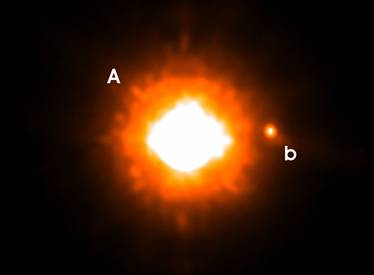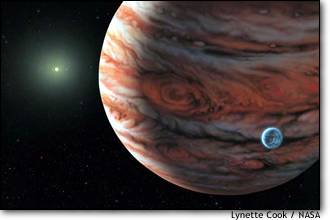|
First Image Successfully Made
Of A Planet Beyond Our Own
Solar System

ESO image of a planet orbiting another star. (A) Star: GQ Lupi (B) The imaged planet. 3/2005
You are seeing a great moment in human history. The image shown above was made
from three images from a telescope of the European Southern Observatory in Chile, the Japansese Subaru telescope and the Hubble
Space Telescope. This represents the very first photograph that has ever been made of a planet from another solar system.
It is a planet that is thought to be at least twice the mass of Jupiter and water
has been detected in its atmosphere. It is orbiting the star "GQ Lupi," a G-Spectral Class sun like our own.
Over 150 planets have been detected around other stars, but they were discovered
through more indirect methods. They were discovered because of the wobble that planets induce in the stars they orbit. This
is the first that was observed and photographed directly.
"GQ Lupi" is considered to be a young star and the discovered planet has been
found to be quite warm. It is also a considerable distance from the star. These factors aided in making the find, which would
normally be a very difficult effort.
You might want to download a copy of this image, which is of great historic importance.
(You can also do the same with other images on this site. Many of them also represent great moments in human discovery.)
We are truly living in a time of exciting and important exploration.
Planets Found Around
Many Stars !
A JPL Announcement
on June 13, 2002
was as exciting as it was startling.

NASA artist, Lynette Cook illustrates new Jupiter like planet
discovered around the star, "55 Cancri" (which is approx.
41 light years from Earth). The little blue moon shown in the
illustration suggests satellites are expected to be found there
as well, some day.
As noted
in the Jet Propulsion Laboratory (JPL) release, the "...planet-hunting team has finally found a planetary system that reminds
them of our own home solar system."
This is
only the latest (on the indicated date) in a growing number of planetary discoveries out there. And this newer discovery for
the system being observed is not the first for that star.
As the JPL report
indicates, "The star, "55 Cancri, in the constellation Cancer, was already known to have one planet. That planet is a gas
giant slightly smaller than the mass of Jupiter and whips around the star in 14.6 days at a distance only one-tenth that from
Earth to the Sun."

This is an illustrative graphic of the new discovery.
The report
further states that, "We haven't yet found an exact solar system analog, which would have a circular orbit and a mass closer
to that of Jupiter. But this shows we are getting close, we are at the point of finding planets at distances greater than
4 Astronomical Units from the host star." (An Astronomical Unit [AU] is the 93-million mile Earth-Sun distance.)
It should
also be noted that this find brought the total number of planets discovered outside our solar system to more than 90! And
the number just keeps on growing.
It clearly
suggests a reasonable chance of finding life out there beyond our own system, and possibly at all levels of development. In
other words, planets seem to be very common around suns and there are billions of suns in even the smallest of galaxies and
countless billions of galaxies. The chance for all possible configurations would seem to be very large.
It would seem
that we really are not alone.

|
| NASA IMAGE |
Historic Launch In The Hunt For Planets
March 6, 2009 ... The Kepler
planet-hunting telescope is launched into space from Cape Canaveral. It could be a very important moment in human history.
This new space telescope will be looking for ever so slight
drops in the brightness of stars in areas near the constellations Lyra and Cygnus. It will be looking at over 100,000
stars, some of which are as far as 3,000 light-years from Earth.
Chances are, when you read this historic footnote of human
exploration, the search will already be underway. (Important finds will be noted on this web site.)
The slight decreases in the brightness of stars, every so
often, strongly suggests the passage of one or more planets in front of the observed sun, as seen from Earth. A considerable
amount of revealing calculations can be made from such changes in brightness. It serves as an important opportunity
to identify the sizes of such transiting bodies. Earth-size planets are expected to be able to be identified.
We have already found in excess of 300 planets in other star
systems. However, up to now, most have been large gas giants. The new telescope should be able to gather statistical
evidence for the identification of much smaller bodies that could suggest Earth-like planets and perhaps the possibility of
life as a common phenomenon in our universe.
Equipment that is scheduled to follow will be specific to
the identification of the possibilities of life in these areas now being explored and in other areas as well. So,
the search for life out there goes on. With the Kepler scope and beyond, we continue the quest. We invite you
to follow the results on this web site, at your convenience.
|

